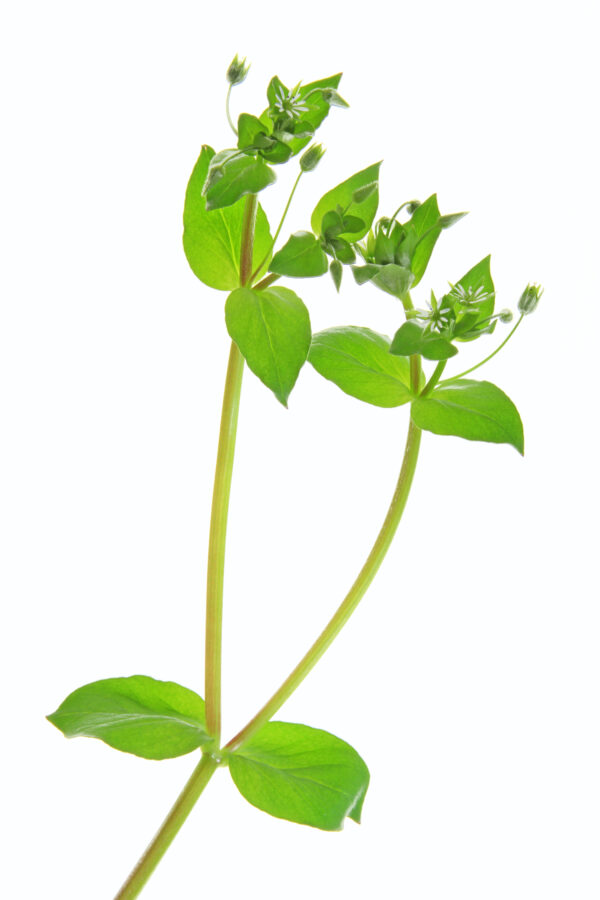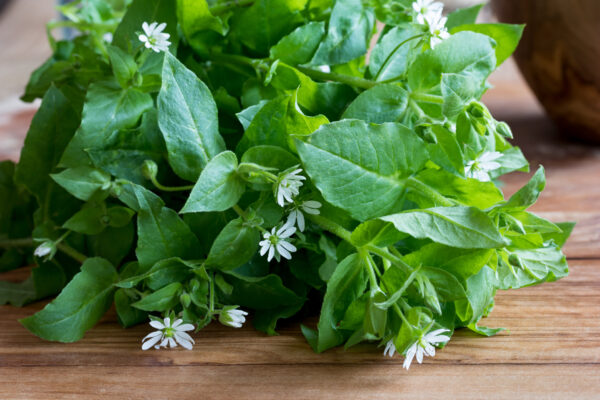Botanical Name: Stellaria media
Common Name: Chickweed, common chickweed, starweed, star chickweed, scarwort, satin flower, stitchwort, chickenwort, adder’s mouth, craches, maruns, winterweed, fuglegrees (Danish), muur (Dutch), stellaire, mouron des oiseaux, langue d’oisaux (French), gansekraut, sternmiere (German), buddelina, centocchio, erba gallina, paperina, stellaria (Italian), hakobe (Japanese), alsina (Portuguese), hierba pajarera, pamplina (Spanish), våtarv (Swedish), cam out (Turkish) (1)
Family Name: Caryophyllaceae
DESCRIPTION
Parts Used: The leaves and aerial portions.

Botanical Description and Habitat: Chickweed is a mat-forming, tender-fleshed, succulent annual herb native to Europe that has naturalized in North America. It grows 7 to 50 cm tall, and is commonly found in gardens and farms where it thrives in cool, moist soils, with growth usually peaking in late winter or early spring.
A line of fine hairs grows along the pale green, angular stem, distinguishing chickweed from its relatives. The diminutive pale green leaves (8-45 mm long) are ovate and shiny, sometimes sparsely coated with fine hairs. (2) The inflorescences have a few tiny, pretty flowers (2-5 mm diameter). Each inflorescence has five lanceolate sepals (3-6 mm long) and five white, deeply bilobed petals that are slightly shorter than the sepals. (2,3) Each flower usually has three to eight stamens and three curved styles. (3) Small ovoid capsules produce reddish kidney-shaped to round seeds. (3)
Note: Chickweed can be confused with Cerastium, a member of the Caryophyllaceae family. Cerastium is distinguished by stems completely covered with fine hairs; chickweed has a single line of hair along one side of the stem. Cerastium is relatively harmless to consume.
The Name: The genus name Stellaria derives from the Latin stella (“star”), referring to the shape of the flower.4 The epithet media derives from the Latin medius (“the middle”). (4) Chickweed and chickenwort refer to wild and domestic birds’ fondness of the seeds and aerial portions.

Historical Uses: Chickweed was a common pot herb, eaten as a fresh or steamed green. The juice was consumed as an antiscorbutic and depurative (“blood purifier”) for rheumatism. (1) The tea was ingested to alleviate coughs, hoarseness, and constipation. (1) Chickweed was combined with elecampane (Inula) for hydrophobia. (1) The fresh herb was infused in lard and applied topically to sores, skin conditions, and hemorrhoids.1 Nicholas Culpeper applied the bruised herb or juice over the liver area to alleviate heat. (1) The juice and tea were applied to the eyes. Cows, horses, sheep, pigs, chickens, and rabbits feed on chickweed. (1)
Constituents: Chickweed contains carboxylic acids, coumarins, hydroxycoumarins, glycosides, flavonoids (rutin), saponins, steroids, triterpene glycosides, vitamins, and minerals. (5, 6)
Nutritional Properties: Chickweed contains high amounts of aluminum, ash, calcium, cobalt, fat, iron, magnesium, manganese, phosphorus, potassium, protein, silicon, sodium, vitamin A, and zinc. It contains low to average amounts of chromium, crude fiber, dietary fiber, niacin, riboflavin, selenium, thiamine, and vitamin C. (7)
Medicinal Properties: Anti-inflammatory, antidyscratic, aperient, demulcent, diuretic, expectorant, laxative, nutritive, refrigerant, emollient, vulnerary, and antirheumatic.
Energetic Properties: Cool, sweet, salty, and bland.
MEDICINAL USES

Chickweed is a highly effective demulcent and emollient. (1, 5) It contains mucilage that reduces inflammation in the mucous membranes and skin. (8) The tea, juice, and succus are soothing for upper and lower respiratory tract infections, hoarseness, sore throats, laryngitis, pharyngitis, tracheitis, or colds. (1,6) However, additional anti-infective agents are needed to treat a microbial infection. A mouthwash or gargle reduces mouth or throat inflammation. The mucilage enhances expectoration, and has subtle antitussive properties beneficial for treating dry coughs due to whooping cough or bronchitis. (1,6) Infusing chickweed with calendula (Calendula), anise (Pimpinella), coltsfoot (Tussilago), mullein (Verbascum), and a pinch of licorice root (Glycyrrhiza glabra) soothes the respiratory system.
Reduces Inflammation of the Digestive Tract
Chickweed aids in treating inflammation and ulceration in the skin, mouth, esophagus, stomach, intestine, and colon. (8) The tea and juice reduce pain and unpleasant sensations resulting from a hiatal hernia, gastritis, gastric reflux, acid indigestion, and peptic or duodenal ulcers. Chickweed reduces chronic inflammation resulting from gastrointestinal conditions, such as irritable bowel syndrome, Crohn’s disease, diarrhea, dysentery, and ulcerative colitis. It is best to consume the tea or juice on an empty stomach when treating the aforementioned conditions. Regardless of whether the mucilage has direct or indirect soothing effects on the urinary and respiratory tracts, it is believed to suppress nerve reflexes in the alimentary canal walls, reducing pain in mucous membranes. A well-strained infusion of chickweed tea can be administered as an enema to reduce acute inflammation in the rectum or colon. It combines well with catnip (Nepeta) and chamomile (Matricaria). An enema is also beneficial for encouraging elimination when treating severe constipation or impacted bowels.

Chickweed tea soothes kidney and bladder irritation, and has mild diuretic actions. It reduces burning sensations and irritation accompanying cystitis and urethritis. When treating infections in the urinary tract or bladder, additional antibacterial agents are necessary, such as usnea (Usnea) and uva ursi (Arctostaphylos). Chickweed tea subtly reduces renal and bladder irritation due to passing kidney stones or kidney inflammation.
Cooling Yin Tonic
Chickweed is a refrigerant and cooling yin tonic. It increases yin fluids and reduces dryness throughout the body. Chickweed can be used as a long-term treatment for yin deficiency or yin deficiency with heat signs (hot flashes and night sweats). It is a restorative tonic that can be consumed following a debilitating illness, childbirth, severe fever, or dehydration, as well as during or after radiation or chemotherapy treatments.
Gentle Laxative
Chickweed tea has gentle laxative properties. (1) It lubricates the stools and contains fiber, a bulking agent. It is a preferred long-term tonic for treating constipation because it does not cause dependency like many cathartic or purgative laxatives.
![]()

Nutrient-Dense and Delicious
Chickweed is a nutritive tonic with high levels of easily assimilated vitamins and trace minerals. The vitamin A and C content supports immune function. The minerals have an alkalinizing effect on tissues. Chickweed is a gentle long-term tonic that alleviates conditions resulting from hyperacidity in the tissues, such as gout, arthritis, and skin conditions (acne, eczema, or psoriasis).
Soothing Topical Anti-inflammatory and Drawing Poultice
Topical applications of chickweed (a poultice, wash, fomentation, or bath) reduce inflammation, and are highly effective for treating dry, itchy skin conditions such as eczema, psoriasis, dandruff, poison oak, and poison ivy. (5, 6) Apply the fresh plant poultice to insect bites, bee, wasp, or nettle stings, burns, ulcers, bed sores, mastitis, wounds, and hemorrhoids. (5, 6, 8) The fresh plant poultice has drawing properties that suppurate poisons and infections, promote the healing of abscesses and chronic sores, and reduce necrotic tissue. Hot chickweed compresses aid in treating boils, abscesses, carbuncles, furuncles, benign cysts, and splinters. (1, 5) Chickweed applications also soothe abrasions, cradle cap, rashes, and other skin conditions. (8) Strain the fresh juice or an infusion through a coffee filter or fine mesh to create an eyewash, or apply it as a sitz bath to soothe vaginal and rectal tissues. (1)
CONTRAINDICATIONS
Excessive consumption of chickweed may result in loose stools; decrease the dosage or discontinue use if this occurs.
 METHODS OF PREPARATION AND DOSAGE
METHODS OF PREPARATION AND DOSAGE
Tincture: Fresh aerial portions [1:3-1:4, 80-95% alcohol]; consume 30-90 drops, up to four times daily. Note: The succus or tea preparations are preferable for reducing inflammation in the mucous membranes.
Succus: Juice the fresh plant, freeze it in small ice cube trays, and store it in a zip-lock bag in the freezer. Alternatively, measure the juice volume and add 15-20% (of 95% alcohol) to the total volume as a preservative. Refrigerate. Consume one teaspoon to one tablespoon, up to four times daily.
Tea: Prepare a hot infusion; consume 8-12 ounces, up to four times daily.
Topical Use: Apply the macerated herb as a fresh poultice, or wilt the herb for several days and prepare infused oil using the double boiler method.
Culinary Use: The fresh herb is delicious in salad, pesto, pâté, and soup, or steamed.
Works Cited
- Grieve M. A Modern Herbal. Great Britain: Jonathan Cape Ltd.; 1931: 195-196.
- Hartman RL, Rabeler RK. Jepson Flora Project. Jepson eFlora Website. http://ucjeps.berkeley.edu/cgi-bin/get_IJM.pl?tid=45497. Accessed March 27, 2015.
- Stellaria media. Flora of North America. eFloras Web site. Missouri Botanical Garden, St. Louis, MO & Harvard University Herbaria, Cambridge, MA. http://efloras.org/florataxon.aspx?flora_id=1&taxon_id=200007072. Accessed March 27, 2015.
- Charters ML. Wrightii. California Plant Names: Latin and Greek Meanings and Derivations Web site. http://www.calflora.net/botanicalnames. Accessed March 27, 2015.
- Leung AY, Foster S. Encyclopedia of Common Natural Ingredients Used in Food, Drugs, and Cosmetics. 2nd ed. Hoboken, NJ: A John Wiley & Sons, Inc.; 2003: 159-160.
- Skenderi G. Herbal Vade Mecum. Rutherford, NJ: Herbacy Press; 2003: 97-98.
- Pedersen M. Nutritional Herbology: A Reference Guide to Herbs. Warsaw, IN: Wendell W. Whitman Company; 1998: 72-73.
- Willard T. The Wild Rose Scientific Herbal. Calgary, AB: Wild Rose College of Natural Healing; 1998: 79-81.
Excerpt from The Essential Guide to Western Botanical Medicine by Christa Sinadinos.
© Copyright – Christa Sinadinos



